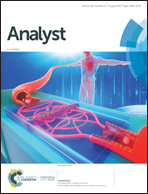A dandelion-like liposomes-encoded magnetic bead probe-based toehold-mediated DNA circuit for the amplification detection of MiRNA†
Abstract
The development of facile and sensitive miRNA quantitative detection methods is a central challenge for the early diagnosis of miRNA-related diseases. Herein, we propose a strategy for a liposome-encoded magnetic bead-based DNA toehold-mediated DNA circuit for the simple and sensitive detection of miRNA based on a toehold-mediated circular strand displacement reaction (TCSDR) coupled with a personal glucometer (PGM ). In this strategy, a glucoamylase-encapsulated liposomes (GELs)-encoded magnetic bead (GELs-MB) probe is designed to integrate target binding, magnetic separation, and signal response. Upon sensing the target miRNA-21, a GELs-MB probe-based toehold-mediated circular strand displacement reaction (TCSDR) was initiated with the help of fuel-DNA, constructing a DNA circuit system, and realizing target recycling amplification and the disassembly of the liposomes. The disassembled liposomes were finally removed via magnetic separation, and the encapsulated glucoamylase was liberated to catalyze amylose hydrolysis with multiple turnovers to glucose for a PGM readout. Benefiting from target recycling amplification initiated by the toehold-mediated DNA circuit and the liposome multiple-label amplification, a small quantity of target miRNA-21 can be transformed into a large glucose signal. The strategy realized the quantification of miRNA-21 down to a level of 0.7 fM without enzymatic amplification or precise instrumentation. Moreover, the high-density GELs-MB probe allows the sensitive detection of miRNA-21 to be accomplished within 1.5 h. Furthermore, this strategy exhibits the advantages of specificity and simplicity, since a toehold-mediated strand displacement reaction, magnetic separation and portable PGM were used. Importantly, this strategy has been demonstrated to allow the high-confidence quantification of miRNA. Therefore, with the advantages of low cost, ease of use, portability, and sensitivity, the reported method holds great potential for the early diagnosis of miRNA-related diseases.



 Please wait while we load your content...
Please wait while we load your content...